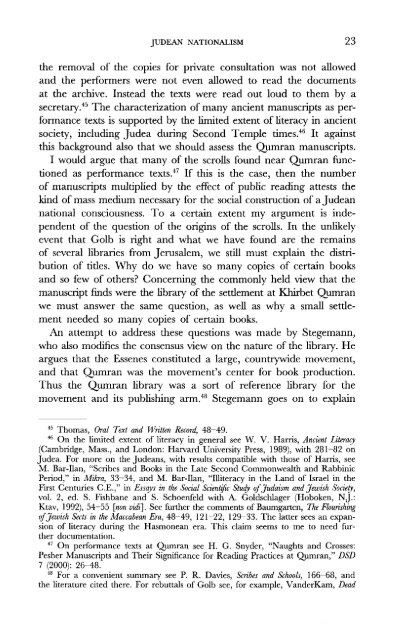historical perspectives: from the hasmoneans to bar kokhba in light ...
historical perspectives: from the hasmoneans to bar kokhba in light ...
historical perspectives: from the hasmoneans to bar kokhba in light ...
Create successful ePaper yourself
Turn your PDF publications into a flip-book with our unique Google optimized e-Paper software.
JUDEAN NATIONALISM 23<br />
<strong>the</strong> removal of <strong>the</strong> copies for private consultation was not allowed<br />
and <strong>the</strong> performers were not even allowed <strong>to</strong> read <strong>the</strong> documents<br />
at <strong>the</strong> archive. Instead <strong>the</strong> texts were read out loud <strong>to</strong> <strong>the</strong>m by a<br />
secretary. 45 The characterization of many ancient manuscripts as performance<br />
texts is supported by <strong>the</strong> limited extent of literacy <strong>in</strong> ancient<br />
society, <strong>in</strong>clud<strong>in</strong>g Judea dur<strong>in</strong>g Second Temple times. 46 It aga<strong>in</strong>st<br />
this background also that we should assess <strong>the</strong> Qumran manuscripts.<br />
I would argue that many of <strong>the</strong> scrolls found near Qumran functioned<br />
as performance texts. 47 If this is <strong>the</strong> case, <strong>the</strong>n <strong>the</strong> number<br />
of manuscripts multiplied by <strong>the</strong> effect of public read<strong>in</strong>g attests <strong>the</strong><br />
k<strong>in</strong>d of mass medium necessary for <strong>the</strong> social construction of a Judean<br />
national consciousness. To a certa<strong>in</strong> extent my argument is <strong>in</strong>dependent<br />
of <strong>the</strong> question of <strong>the</strong> orig<strong>in</strong>s of <strong>the</strong> scrolls. In <strong>the</strong> unlikely<br />
event that Golb is right and what we have found are <strong>the</strong> rema<strong>in</strong>s<br />
of several libraries <strong>from</strong> Jerusalem, we still must expla<strong>in</strong> <strong>the</strong> distribution<br />
of titles. Why do we have so many copies of certa<strong>in</strong> books<br />
and so few of o<strong>the</strong>rs? Concern<strong>in</strong>g <strong>the</strong> commonly held view that <strong>the</strong><br />
manuscript f<strong>in</strong>ds were <strong>the</strong> library of <strong>the</strong> settlement at Khirbet Qumran<br />
we must answer <strong>the</strong> same question, as well as why a small settlement<br />
needed so many copies of certa<strong>in</strong> books.<br />
An attempt <strong>to</strong> address <strong>the</strong>se questions was made by Stegemann,<br />
who also modifies <strong>the</strong> consensus view on <strong>the</strong> nature of <strong>the</strong> library. He<br />
argues that <strong>the</strong> Essenes constituted a large, countrywide movement,<br />
and that Qumran was <strong>the</strong> movement's center for book production.<br />
Thus <strong>the</strong> Qumran library was a sort of reference library for <strong>the</strong><br />
movement and its publish<strong>in</strong>g arm. 48 Stegemann goes on <strong>to</strong> expla<strong>in</strong><br />
45 Thomas, Oral Text and Written Record, 48-49.<br />
46 On <strong>the</strong> limited extent of literacy <strong>in</strong> general see W. V. Harris, Ancient Literacy<br />
(Cambridge, Mass., and London: Harvard University Press, 1989), with 281-82 on<br />
Judea. For more on <strong>the</strong> Judeans, with results compatible with those of Harris, see<br />
M. Bar-Ilan, "Scribes and Books <strong>in</strong> <strong>the</strong> Late Second Commonwealth and Rabb<strong>in</strong>ic<br />
Period," <strong>in</strong> Mikra, 33-34, and M. Bar-Ilan, "Illiteracy <strong>in</strong> <strong>the</strong> Land of Israel <strong>in</strong> <strong>the</strong><br />
First Centuries C.E.," <strong>in</strong> Essays <strong>in</strong> <strong>the</strong> Social Scientific Study of Judaism and Jewish Society,<br />
vol. 2, ed. S. Fishbane and S. Schoenfeld with A. Goldschlager (Hoboken, N.J.:<br />
Ktav, 1992), 54-55 [non vidi]. See fur<strong>the</strong>r <strong>the</strong> comments of Baumgarten, The Flourish<strong>in</strong>g<br />
of Jewish Sects <strong>in</strong> <strong>the</strong> Maccabean Era, 48-49, 121-22, 129-33. The latter sees an expansion<br />
of literacy dur<strong>in</strong>g <strong>the</strong> Hasmonean era. This claim seems <strong>to</strong> me <strong>to</strong> need fur<strong>the</strong>r<br />
documentation.<br />
47 On performance texts at Qumran see H. G. Snyder, "Naughts and Crosses:<br />
Pesher Manuscripts and Their Significance for Read<strong>in</strong>g Practices at Qumran," DSD<br />
1 (2000): 26-48.<br />
48 For a convenient summary see P. R. Davies, Scribes and Schools, 166-68, and<br />
<strong>the</strong> literature cited <strong>the</strong>re. For rebuttals of Golb see, for example, VanderKam, Dead

















